
The Pacific Voyages
of Rollo Beck
Collection of Oceanic Photographs
and Objects
The Expedition Continues
West
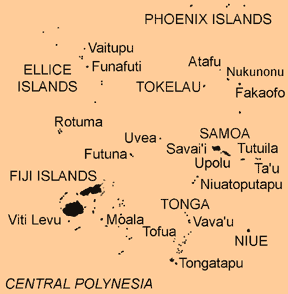
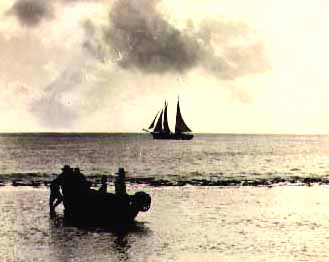
The France left the Societies
in December of 1923 and set her sails towards central Polynesia. The expedition
spent the first six months visiting the islands of Samoa and then went on to
Fiji where they remained for another sixteen months. The Fiji Island group comprises
over 300 islands and Beck was determined to collect from different islands looking
for variation within bird species. While in Fiji, Beck remarked on the linguistic
similarities of Fiji and the Solomons to lend strength to his theory that a
bird called the yasaca or "saca" in Fijian, had never lived in Fiji.
He theorized instead that only the legend of its existence had been brought
to Fiji via the Solomons.

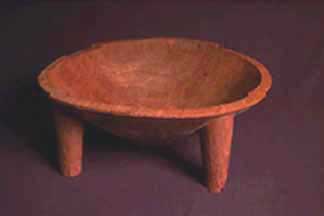
Fiji kava drinking
/ Kava bowl
CAS 1984-0008-0367
Kava is a white milky drink
known for its intoxicating or euphoric effects and is derived from Piper
methysticum, a pepper plant. Kava drinking was once an integral part of
religious, economic, and political life throughout the Pacific. Today it is
seldom seen in East Polynesia or most of Micronesia, but in Western Polynesia
and much of Melanesia, kava drinking still figures prominently. Kava is prepared
by first crushing the root and mixing it with water after which the mixture
is left to ferment. It is generally presented in a large bowl and is served
in small coconut shell cups. The accompanying ceremony in Fiji involves a clap
of the hands before sipping.
The Whitney Expedition next visited Tonga during July and August of 1924. In
Nuku'alofa of the Tongatapu group, Beck records his observations of the locals,
"Tapa making and mat weaving are principal occupations of the women while
the men do most of the field work. Open spaces in the coconut groves [are] being
planted to [sic] yams, taro, manioc, etc."
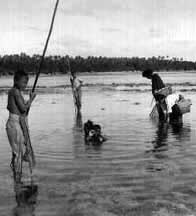
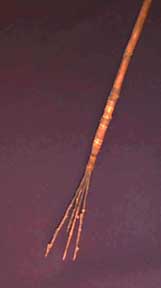

Reef Fishing /
Fishing spear / Tongan children with their spears
CAS 1988-0007-0005
"We reached the shore
around seven o'clock and found the women and children returning from the reef
with small shell fish. In the afternoon several men with long handled spears
walked out on the reef to spear any unlucky fish of eatable size that might
be found in a channel or pool."
While in Tonga, one of the Expedition's crew members met an old blind woman
on Fanualei Island who told him that the last time a vessel the size of the
France had come to their island was sixty years earlier and it had "taken
a lot of people to Peru as slaves." (Maude 1981.)
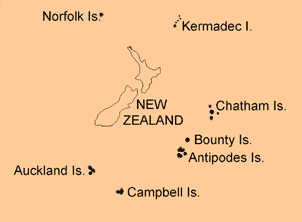
In October of 1924, the Whitney
Expedition left Polynesia for New Zealand where it remained for only two months.
The Expedition had difficulty getting permission to collect birds in New Zealand
and even after they were given permits which limited the number of birds they
could take, local environmental groups protested, criticizing Beck for taking
their rare and endangered birds. On January 12, 1926, they began making their
way north to Vanuatu, which was then called the New Hebrides.
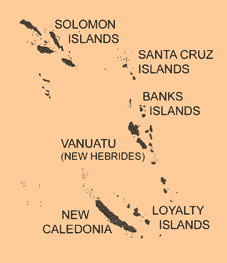
Children
wearing tortoise shell earrings like those pictured from our collection
CAS 1984-0008-0279
On Reef Island of the Vanuatu
group Beck wrote "the natives have a great liking for tortoise shell earrings.
They were worn by children of both sexes."
Beck next led his group to the Solomon Islands where they collected for nearly
seventeen months before heading east to the Bismarck Archipelago.


A canoe
of the Solomon Islands / Canoe
oar from the collection
CAS 1984-0008-0420

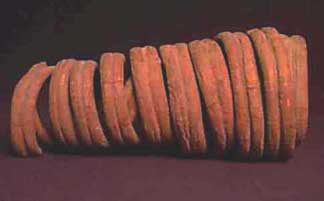
Solomon
Islander with bow guard and bow / Bow guard
CAS 0259-0003
In the Solomons Beck noted
"the natives on Malekula hunted with guns and here they all carry bows
and arrows."

 Ida Beck
with a Solomon Islander holding a club / Club
Ida Beck
with a Solomon Islander holding a club / Club
CAS 1984-0008-0261
Ticopia:"George, our
mate, being related to the chiefs of Tonga, spends the night on shore and gets
some data of interest, to him at least. The people here were originally blown
off from Tonga and settled [the] island."
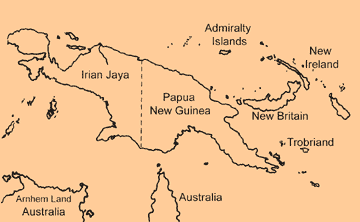
Early in 1928, the Whitney
Expedition arrived in Papua New Guinea where it remained until the conclusion
of the project at the end of the following year.


Papuan
men with drums/ Drum from the collection
CAS 1994-0009-0021
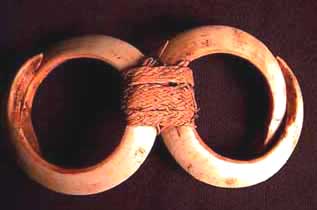


Tusk pendant
/ Papuan man wearing pendants
CAS 0435-0015
Beck returned to
the United States in 1929 after eight years of working in the Pacific. The team
had collected over forty thousand birds for the Museum of Natural History.
The photographs of Rollo Beck and the objects he collected which were shown
in these pages represent only a small sample of those which are housed in the
Department of Anthropology at the California Academy of Sciences.
To find out
more about our Oceanic collection, visit our online
collection database. Search on the Global Region: "Oceania" and
the category or object of your choice.
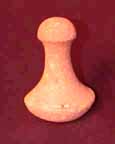
For a list of related reading material, click on the poi pounder.
CAS 0458-0316











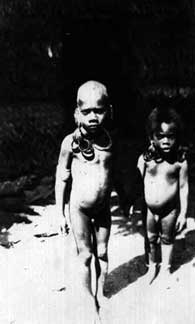
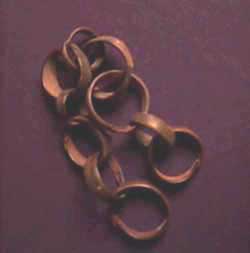











![]()